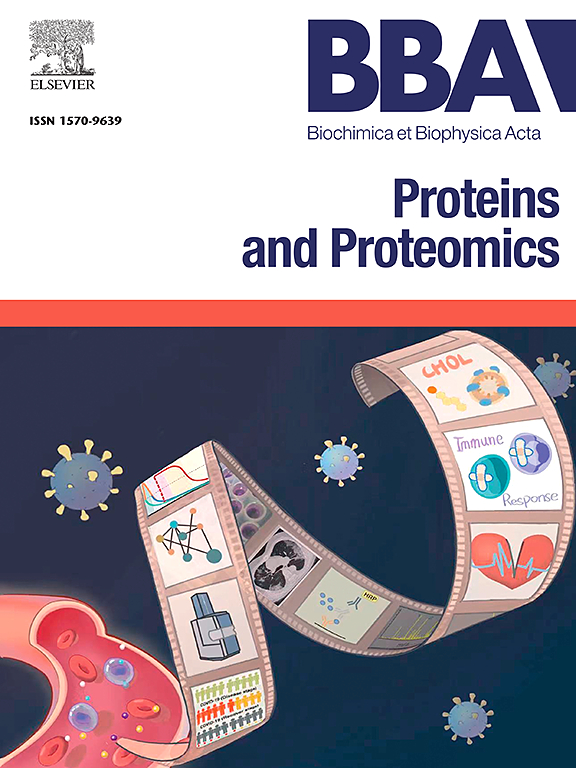在原子水平上探索人类羧酸酯酶1和2对两个底物家族的选择性
IF 2.3
4区 生物学
Q3 BIOCHEMISTRY & MOLECULAR BIOLOGY
Biochimica et biophysica acta. Proteins and proteomics
Pub Date : 2025-04-08
DOI:10.1016/j.bbapap.2025.141069
引用次数: 0
摘要
人体羧酸酯酶(CES)是在多种物质的代谢和生物转化中起重要作用的酶。CES1A1和CES2A1这两个更相关的同工异构体催化了许多已批准的药物和前药的水解。阐明CES异构体底物的特异性是一个非常相关的药物化学问题。一般的作用指出,对CES1A1或CES2A1的选择性取决于底物结构中存在的酰基和烷基基团的大小,但关于底物对这两种CES的乱交也有一些例外的报道。本文采用经典分子动力学(MD)和混合量子力学/分子力学(QM/MM)模拟相结合的方法,研究了CES1A1和CES2A1在对硝基苯基酯衍生物(NPE)和拟除虫菊酯立体异构体(Pyr)上的底物选择性。经典分子模型研究表明,在CES1A1和CES2A1子口袋1和子口袋2上存在疏水残基的相互作用的范德华(VDW)组分对底物- ces亲和性能有重要贡献。混合QM/MM模拟表明,所研究的底物反应的限速步与具有较高位阻分子结构的过渡态(TS)有关。综上所述,可以观察到所研究的底物与亚口袋1和2中的残基产生最佳的相互作用模式,从而产生相应的与酶的亲和力常数。然后,这种相互作用模式通过在限速反应的分子结构中存在或不存在高位阻中心来驱动催化翻转反应。本文章由计算机程序翻译,如有差异,请以英文原文为准。

Exploring human carboxylesterases 1 and 2 selectivity of two families of substrates at an atomistic level
Human carboxylesterases (CES) are enzymes that play an important role in the metabolism and biotransformation of diverse substances. The two more relevant isoforms, CES1A1 and CES2A1, catalyze the hydrolysis of numerous approved drugs and prodrugs. The elucidation of CES isoform substrates specificity constitutes a very relevant medicinal chemistry issue. The general role pointed that the selectivity towards CES1A1 or CES2A1 depends on the size of the acyl and alkyl moieties present in the structure of the substrate, but several exceptions regarding substrate promiscuity towards both CES have been reported. In this work, a combination of classical molecular dynamics (MD) and hybrid quantum mechanics/molecular mechanics (QM/MM) simulations were applied with the purpose of studying the substrate selectivity of CES1A1 and CES2A1 on two sets of selected ligands: p-nitrophenyl ester derivatives (NPE) and pyrethroid stereoisomers (Pyr). The classical molecular modeling studies showed that the van der Waals (VDW) component of interaction, with the hydrophobic residues present on CES1A1 and CES2A1 subpocket 1 and subpocket 2, showed a significant contribution to the substrates-CES affinity properties. The hybrid QM/MM simulations exhibited that the rate-limiting step for the studied substrates reactions were related to the transition state (TS) with the higher steric hindrance molecular structure. In conclusion, it was possible to observe that the studied substrates generate the best possible interaction pattern with the residues from subpocket 1 and 2 in order to produce the corresponding affinity constant with the enzyme. Then, this interaction pattern drives the catalytic turn-over reaction through the presence or absence of a high steric hindrance center in the molecular structure of the rate-limiting reaction.
求助全文
通过发布文献求助,成功后即可免费获取论文全文。
去求助
来源期刊
CiteScore
8.00
自引率
0.00%
发文量
55
审稿时长
33 days
期刊介绍:
BBA Proteins and Proteomics covers protein structure conformation and dynamics; protein folding; protein-ligand interactions; enzyme mechanisms, models and kinetics; protein physical properties and spectroscopy; and proteomics and bioinformatics analyses of protein structure, protein function, or protein regulation.

 求助内容:
求助内容: 应助结果提醒方式:
应助结果提醒方式:


